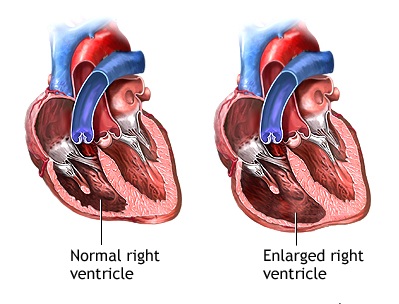Tricuspid regurgitation, also known as tricuspid valve insufficiency, is a condition that occurs when the tricuspid valve is not able to close properly, resulting in backward flow of blood to the right atrium (upper heart chamber) when the right ventricle (lower heart chamber) contracts. It is a rare condition and it affects only 0.9 % of Americans per annum. If the condition is not very serious, monitoring without treatment is enough. If it is serious, you need medical attention.

Causes of Tricuspid Regurgitation
1. Right Ventricular Dilation
The condition commonly occurs as a result of right ventricle dilation. The right ventricle is in charge of pumping blood from the heart to the lungs. When the ventricle is pushed to work harder, it becomes bigger in order to compensate. This results in the enlargement of the annulus (the ring of the tricuspid valve). The annulus offers support to the opening and closing of the valve. Different disorders can cause the enlargement to occur. They include pulmonary stenosis, left-side heart disorders, pulmonary hypertension and emphysema.
2. Ineffective Endocarditis
Ineffective endocarditis infection occurs as a result of bacteria entering the blood stream and settling in a heart valve, heart lining or even a blood vessel. It refers to an infection in the heart lining and it casts a threat to the valves in the heart chambers.
3. Medication
It can also be caused by medication used to treat Parkinson’s disease and restless leg syndrome. Examples are pergolide, which has been removed from the US market, as well as cabergoline.
4. Other Causes
Occurrence of a heart attack might damage the heart and affect the functioning of the tricuspid valve and the right ventricle. Heart failure is another factor to put you at risk. The tricuspid valve can also be affected by chest radiation leading to tricuspid valve insufficiency.
Symptoms of Tricuspid Regurgitation
Some of the symptoms include:
- Irregular heart rhythm
- Fatigue
- A fluttering neck discomfort
If the condition is serious, it may distort the forward movement of blood causing symptoms similar to those of congestive heart failure. They include leg swelling or fluid retention in any part of the body and shortness of breath, more so when lying flat or with exertion.
Treatment for Tricuspid Regurgitation
1. Regular Monitoring
If your condition is mild, you only need follow up checkups with your doctor to monitor the condition.
2. Medication
Medications may be prescribed for symptoms of severe conditions like heart failure. Such medications may include drugs that prevent diuretics. If you are experiencing irregular heart rate and rhythm, medications can be prescribed to control both the rate and the rhythm.
3. Catheter Ablation
Catheter ablation is an invasive procedure to selectively destroy a faulty electric pathway of the heart. During the procedure, one or more catheters can be led to your heart through blood vessels. The tips of the catheters contain electrodes. Freezing, head or radio therapy is used to damage a small part of the heart tissue creating an electrical barricade along the path that is causing the irregular heart rhythm.
4. Surgery
If you have clear signs and symptoms of tricuspid regurgitation, surgery might be recommended to replace or repair the tricuspid valve. This can also be recommended in the case where the heart enlarges and its function decreases. In some instances, a surgery can be recommended if the heart size is increasing and you have mild or no signs or symptoms. If you are going through a heart surgery and you have the conditon, the doctor might opt to fix it as well.
- Heart Valve Repair
In some cases, the surgeon might opt to repair the valve rather than replace it. This can be done either by reshaping the leaflets such that they are in contact to avoid backward flow of blood or by sealing the holes on the leaflets. To stabilize and tighten the repair, a partial band is placed on the valve. This is referred to as annuloplasty. There is a new form of repair called cone repair which involves detaching the leaflets from the heart muscle, rotating them and reattaching them to create a cone like shape.
- Heart Valve Replacement
In the case where it is not possible to repair the valve, the surgeon might have to replace the faulty valve with a bio prosthetic (biological tissue) valve to treat tricuspid regurgitation. If you have a mechanical valve, you must take blood thinning medication to ensure that clots do not form around the new valve. Sometimes, the bio-prosthetic valve fails to function after some time and a new one has to be anchored on it.
- Maze Procedure
During surgery to repair or replace the valve, the surgeon can create a maze of scar issue on your heart by making small incisions in the upper heart chambers. This is to deal with the problem of irregular heart rhythm. Irregular electric impulses cannot be transmitted on scared tissue. Radiotherapy or freezing can be used to create scared tissue.
